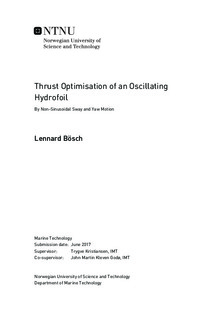Thrust Optimisation of an Oscillating Hydrofoil - By Non-Sinusoidal Sway and Yaw Motion
Master thesis
Permanent lenke
http://hdl.handle.net/11250/2453077Utgivelsesdato
2017Metadata
Vis full innførselSamlinger
- Institutt for marin teknikk [3421]
Sammendrag
Past research has shown that oscillating hydrofoils can enhance the propulsion efficiency significantly compared to traditional propellers. Dynamic stall plays an important role in the thrust generated by an oscillating hydrofoil, combining this with non-sinusoidal motion makes it an complicated phenomenon to investigate.
Genetic optimisation algorithms are employed to optimise the motion for thrust efficiency of a NACA0015 foil with a 7.5 cm chord oscillating in sway and yaw. The optimisation algorithm selects motion-parameters during model-scale experiments, and adjusts these to optimise thrust efficiency. Experiments are conducted in a circulating water tunnel (CWT) at the Norwegian University of Science and Technology (NTNU). Thrust efficiency was successfully increased compared to previous research, where traditional parametric search methods were applied.
Two different flow conditions are considered: one at low Reynolds number with a wide range of Strouhal number; and another with higher Reynolds number, and a turbulent boundary layer through turbulence stimulation. Thrust efficiency is measured to above 60 % for a wide range of thrust coefficients at: 0.02-0.6. If drag at zero angle of attack is disregarded, efficiencies above 90 % are observed for thrust coefficients below 0.2.
Previous experiments by J. Anderson, Streitlien, Barrett, and Triantafyllou (1998) were successfully repeated. Good agreement was found for many of their results, except for a few cases.
The phase between sway and yaw showed a tendency towards 75° if the Strouhal number is above 0.2, for which a reverse Von Karman vortex street is expected.
For further work, all results from the optimisation experiments are listed in the attached ".csv" file, raw-data is available on request. The data generated for the optimisation experiments is enormous. A lot can still be investigated regarding the ideal motion parameters, and how thrust and power consumption varies through one oscillation. Additionaly it would be very interesting to look for similarities between the genetic algorithm, and motions of the dorsal fin on thunniform swimmers (Dolphines, Tunas, etc.). For which the author was unable to find any literature concerning measurements of the exact sway and yaw motion.
